Diana Mosher, an editor with The McMorrow Reports & FMLink, connected with The HON Company team, Anna Wizner, Leslie Eichelberger, Jeremy Tinkler, and Ben Daufeldt, to discuss marketplace insights and solutions.
HON products are made to last. How do you approach durability?
Wizner: Every piece of HON furniture—from initial conceptualization to final design—is created with three benchmarks in mind: thoughtful design, exceptional durability and intuitive solutions. Our products are made to last. HON promotes exhaustive testing to ensure that every product evolves with our industry’s high commercial standards. Developing products that stand the test of time has always been one of our core values. We won’t release a product to market without guaranteeing it lives up to our standards.
Mediocre office furniture can’t provide the kind of support that most office workers need, and considering most people sit in a chair or at a desk most of their day, that can send productivity and motivation packing. Office furniture that promotes physical well-being is, without a doubt, rooted in durability first.
Daufeldt: When we say “made to last” we’re telling people you can rely on us and our product. And, because our customers work in all sorts of environments, from education to local government, they need customized solutions. No matter what the work environment, HON’s goal is to ensure they’re getting maximum productivity, creativity and flexibility out of their space.
You’ve been driving brand awareness with a fresh design aesthetic. Tell us about the impact of aesthetics on your customers’ productivity goals.
Eichelberger: As important as durability and comfort are, aesthetics go a long way in inspiring creativity and productivity. Schools are a great example of why it’s imperative to create a product that’s reliable and sparks imagination. Today’s learning spaces are completely different from the traditional classrooms many of us likely remember. Educators are moving toward experience-based learning that’s focused on creative collaboration—and that energized, innovative approach is fostered by sensible, functional design with a fresh aesthetic that also encourages creativity and joy.
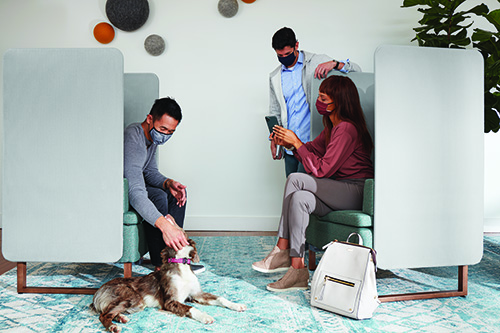
With supportive seating that is flexible enough to fit into existing office space and accessible meeting areas beyond the conference room, the Astir Collaborative Work collection allows for human social distancing while keeping the Australian Shepherd at your feet.
Daufeldt: These ideas don’t just apply to learning environments. A broad range of customers can benefit from durable and customizable design and function—from a small design firm that favors vibrant hubs to a multitasking environment in a no-nonsense government space. In both cases, employees need to be able to tap into a space that stimulates productivity. With HON, you’re not just investing in smart office furniture, you’re investing in the people who are rowing the boat.
Tell us more about HON’s competitive edge?
Wizner: Because HON products are built for the long haul, we view our workspace solutions differently from other brands that might provide a short-term solution, but not much more. HON customers aren’t just investing in a reliable product, they’re investing in the world’s most precious resource: people.
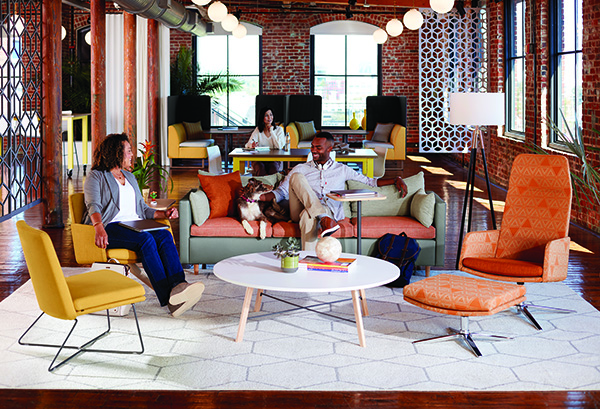
Whether configured for a multi-use zone or as stand-alone statement pieces, Mav single seat lounges are ideal for impromptu gatherings and quick breaks. Just add an ottoman for a longer reading break.
Eichelberger: We love that our solutions address a variety of needs. Not just physical, but emotional. When you can’t focus on work because you’re distracted by physical discomfort, productivity and motivation go out the window. You’re purchasing far more than office furniture when you invest in a HON product. You’re buying peace of mind, physical well-being and a promise of productivity. That’s priceless.
Tinkler: Putting our customers’ needs (and wants) first has been at the heart of HON’s research, innovation and development for decades. It’s one of our core values: to walk in our customers’ shoes and return with ideas, inspiration and information that will help our teams develop the next great product so they can help customers do better work.
How do your team members put themselves into the customers’ shoes?
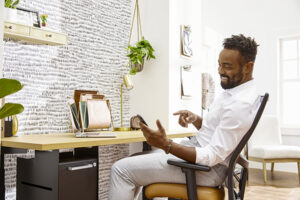
HON offers work from home tips and guides facilities managers in setting up a corporate work from home program with all the essentials.
Wizner: It starts with our culture. Our work begins with understanding the customer: who they are, what they need and how we can leverage our depth of knowledge to help them. We write ourselves into the customer’s story. We focus on the individual user and how they interact with our products. Then we use that information to begin a comprehensive process to solve their problems.
It helps our members really connect to the customer. If they take a step back out of HON’s world, they can start to make decisions and act like the customer when they’re doing things—which is a powerful way to think about it and prepare to solve problems.
How do you generate and develop new product ideas?
Wizner: Our product marketing managers are the engines for new ideas. Sometimes, it’s about what a competitor isn’t doing—and other times, it may be about what HON can do better. To use the analogy of peeling the onion, for us it’s about empathizing and understanding what the customers are looking for and how to best address their needs.
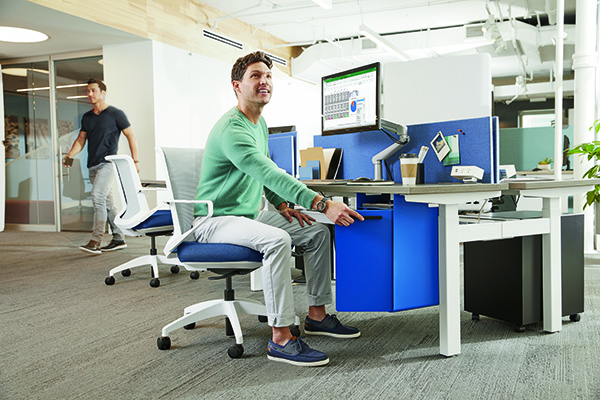
Cliq responds to body movement, so chair height is the only adjustment the user makes with the Cliq task chair, introduced earlier in 2021. Empower benching, also benefits from the Cliq chair and fits more people into a smaller area without sacrificing privacy, style or productivity. It helps planners respond to changes in the organization by easily adapting and expanding to support new team members and varying work styles.
Tinkler: One example is HON’s Cliq task chair, which launched this year. Our product marketing team identified the need for a simple and intuitive chair, one that could be paired cohesively with any product in the office. The focus was on simplicity and comfort for quick meetings and touch-downs; our team saw chairs in workspaces that hadn’t changed position since they were taken out of the box, a sign that some chairs weren’t user-friendly and perhaps too complex. From that research, Cliq was born—and it’s helped people do better work and collaborate safely during uncertain times.
With Cliq, chair height is the only adjustment the user makes. After that, the chair is very intuitive—it responds to body movement, which creates an ideal seating solution for short-duration spaces. Cliq doesn’t just check the comfort box. With modern, streamlined aesthetics and a clean linear back and arms, the chair is sleek and stylish. Plus, Cliq delivers on adaptability and aesthetics. It’s a win/win.
How does HON’s robust dealer network help secure market share?
Eichelberger: Great dealers support great brands. Considerations like design and project management are crucial to building a space which works, while offering brands which have strong warranties, person-to-person customer support and a commitment to service will make your post-sale experience fulfilling and ensure that your furniture lasts far into the future.
HON has the strongest dealer network in the United States. Dealers want to partner with HON because we have comprehensive commercial solutions that cover any type of business from the front entrance to the back office—no matter the size of the company. We also understand the power of value, as budgets are always a consideration, and we have products at the right price points. When we pair these advantages with our powerful dealer network and their capabilities, it allows us to meet and exceed customer expectations. This is what it takes to get it right.
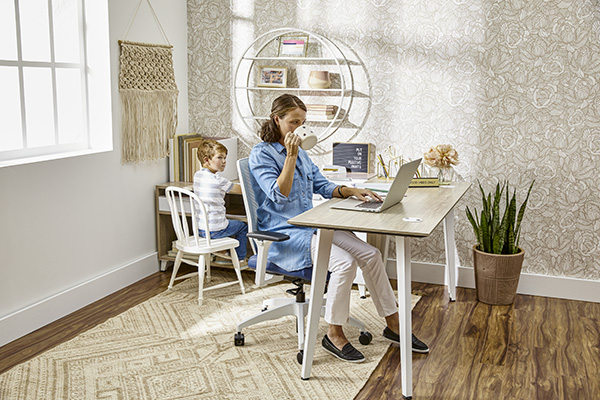
A table crafted with HON Voi worksurfaces and a set of steel angled legs permits wire/cable management and adds the residential touch allowing the office to blend with the home. Voi low credenzas support home office assistants.
Daufeldt: We’re focused on bringing customer spaces to life. It’s a comprehensive approach. We’re the experts in the furniture-buying process, and every step of our process makes that clear to the customer. That’s why we’re focused on making the process simpler.
What trends are you seeing regarding the hybrid workplace?

Mid-Century flair is the hallmark of the Mav collection of upholstered chairs, designed to function well in virtually any space. Mav configures for a multi-use zone or as stand-alone statement pieces.
Wizner: We’re all talking about “hybrid work,” in which employees split time between home and the office. We gleaned a lot from Microsoft’s recent 2021 Work Trend Index, which surveyed more than 30,000 employees. According to the Index, 66% of business decision makers are considering redesigning physical spaces to better accommodate hybrid work environments. The data is clear: extreme flexibility and hybrid work will define the post-pandemic workplace.
The way companies approach the next phase of work—embracing the positives and learning from the challenges of this last year will impact how you retain and recruit talent.
Physical office space must be compelling enough to entice workers to commute in and include a mix of collaboration and focus areas. Meeting rooms and team culture will need to evolve to ensure all voices are heard. In other words, the new office must be modern, and it must be a space that workers want to come to.
Today, it’s uncommon for workers to sit in the same chair all day. Most of us are on the move from collaboration sessions to one-on-one coffee meetings. Having a chair that’s designed to support short duration work areas (one to three hours at a time)—plus a built-in consideration for different body types and workstyles—is a no-brainer. A great solution is HON’s new Cliq task chair.
What are HON’s no fail favorites for the return to work?
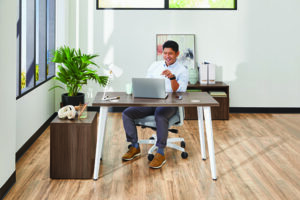
Ignition task seating, designed by Wolfgang Deisig, Deisig Design, Berlin, supports every body type, with a mix of back heights and styles, frames, and mesh colors with Colorway lumbars. Turn the Ignition seat on when you pull up to Voi tables and credenzas to support solo and collaborative work.
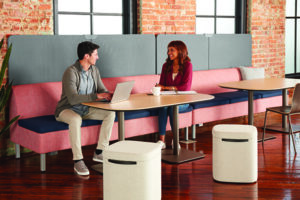
Birk tables are sleek and simple designs with five different table heights, knife or flat edges, worksurface shape, and size variety, any workspace can fit some Birks, giving workers a convenient place to take notes or take five.
Tinkler: Every great office setup starts with a great chair, but most people aren’t working in a good chair. An instant upgrade comes in the form of the HON Ignition 2.0 task chair. Not only is it stylish with its Designer White frame option and customizable colors, it has new features that add to its ergonomic capability.
Workstations should support all types of work—and for this, we recommend a height-adjustable desk that allows employees to stand or sit. This is a healthy habit to get into.
Astir Collaborative Work provides supportive seating flexible enough to fit into your existing office space, and plenty of ways to collaborate with social distancing in mind.
Storage is also a great addition. Contain storage from HON maximizes your office footprint, and is outfitted with bench cushions for mobile seating. Fuse storage is made for today’s aesthetic with a variety of size and color options.









